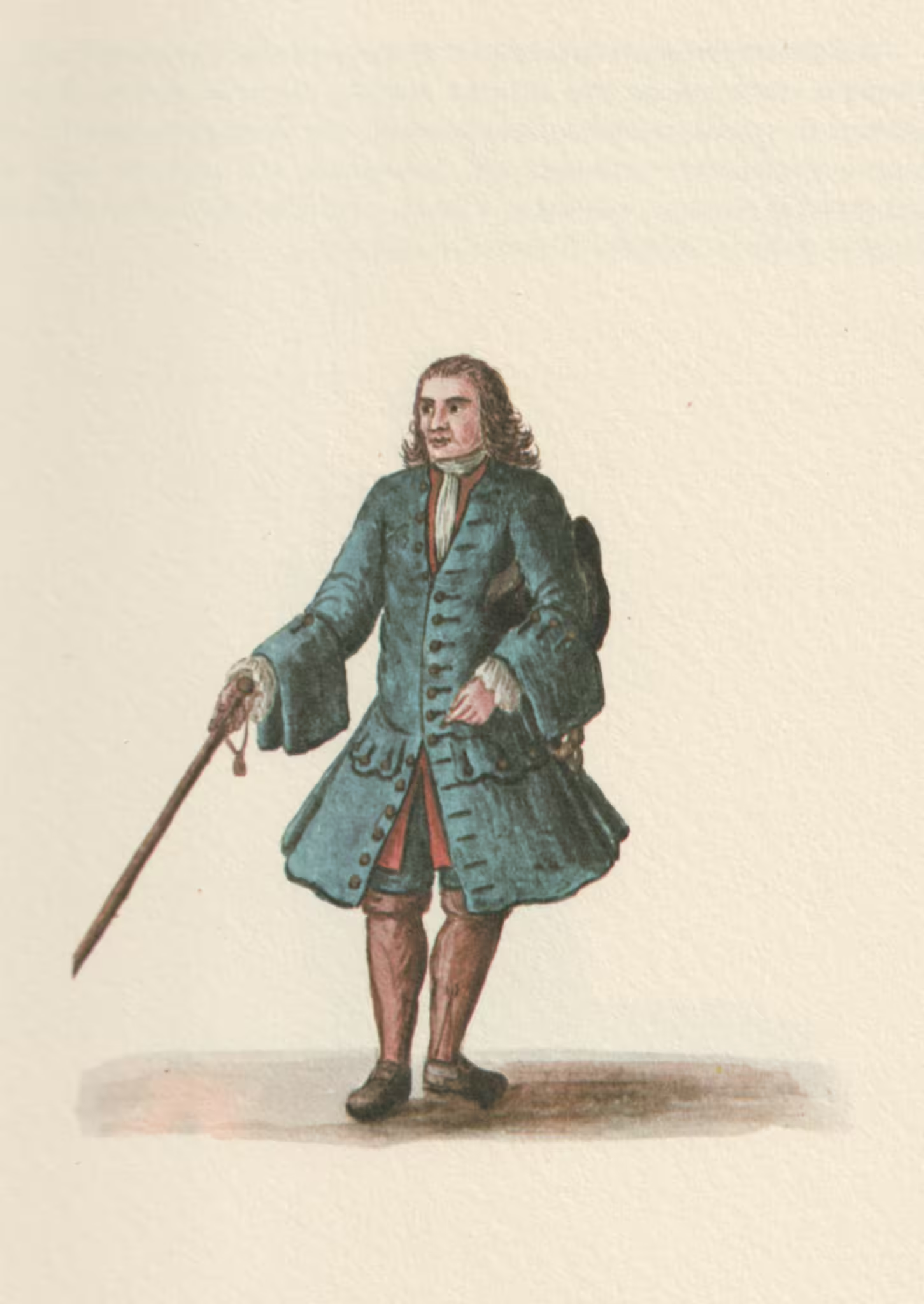The Venetian lazzaretti were managed by a priore, appointed for three-year terms.
This painting depicts the priore of one of the Venetian lazzaretti.
Source: Gli abiti de veneziani di quasi ogni età con diligenza raccolti e dipinti nel secolo XVIII, by Giovanni Grevembroch (1731–1807), which in four volumes contains over six hundred watercolours of how Venetians dressed in the 1700s.

Zealous custodian
In the year 1423, the Signoria built a Lazaretto for the Infected Patients on that Island, which was called Santa Maria in Nazareth,1 with several comfortable rooms, in order to treat the Ailing Patients; then in 1468, another place was built called the New Lazaretto with a large circuit with one hundred rooms;2 and as in the former the plague victims were accepted, so in the latter the suspects were quarantined. These places were tested, especially in the case of the 1576 Contagion, and 1630 for the singular charity of the Republic towards its People in such urgent needs.
In the first case, about ten thousand people were locked up, for whose accommodation three thousand boats, in addition to some larger, and smaller ships, under the care of nobles and citizens,3 who distributed spiritual assistance, food, and medicines according to the Rules prescribed by the Magistrate.
In such an unfortunate encounter, it was pleasing to see such a crowd of objects, which had the appearance of an Army besieging the City, and a Flag was observed overhead, beyond which it was not permitted, under penalty of life, to pass. There was so much order and silence in the evening that one could hear the wonderful harmony of the voices of those who praised God and sang Psalms, turning to Heaven with the deepest of their hearts. A Prior was charged with the burden of the major problems. The duties of those who carried this burden had already been providently dictated in 1438, 28 October, as noted in the first volume of the Archive of the Office of Health. Sabellico and Sansovino added more, which we cannot report due to the limited size of the sheet.
To the Most Faithful and Wise Citizen Donà Michiel, Major with long experience in the Militias existing within the great district of the Veneto Lido.
Notes
- The Lazzaretto Vecchio. ↩︎
- The Lazzaretto Nuovo. ↩︎
- Nobles and citizens were two separate categories of citizenship in the Republic of Venice. ↩︎

Original Italian text
Custodia gelosa
Nell’anno 1423 fù edificato un Lazaretto della Signoria per gl Amorbati in quell’Isola, che si chiamò Santa Maria in Nazareth con diverse commodi Stanze, onde curare gl’ Amalati; poi del 1468 si fabbricò un altro Luogo chiamato il Lazaretto nuovo di amplo circuito con cento Camere; e siccome in quello si accettavano gli Appestati, così in questo li sospetti per farne contumacia. Furono esperimentati questi Luoghi, massime al caso del Contaggio 1576, e 1630 per la singolare carità della Repubblica verso il suo Popolo in bisogni si urgenti.
Nel primo incontro erano chiuse circa dieci milla Persone, per accomodare le quali tremilla Barche, oltre alcuni Arsili, e Legni piccioli supplivano, sotto la cura de Nobili, e Cittadini, i quali distribuivano l’assistenze spirituali, il vivere, e li medicamenti secondo le Regole prescritte dal Magistrato.
In sì infausto incontro, piaceva il vedere tanta folla di cose, che avea sembianza d’un’Armata, che assediasse la Città, e si osservava in alto una Bandiera, oltre alla quale non era lecito, sotto pena della vita, di passare. Tanto ordine, e silenzio, si dispensava sul far della sera, che si sentiva armonia mirabile delle voci di coloro, che lodavano Dio, e cantavano Salmi, rivolti al Cielo col più profondo del cuore. Ad un Priore stava adossata la fatica de principali disturbi. L’incombenze di chi sostenesse tal Carico, erano già state dettate providamente del 1438, 28 Ottobre, come si rilleva nel primo Volume dell’Archivio dell’Officio di Sanità. Il Sabellico, et il Sansovino aggiunse il di più, che noi per la ristrettezza del Foglio, non potiamo estendere.
Al Fedelissimo, e Saggio Cittadino Donà Michiel maggiore di lunga sperienza sopra le Milizie esistenti entro il gran Quartiere del Veneto Lido.
Grevembroch (1981), vol. 4, p. 43.
Related articles
- Gli abiti de veneziani — by Giovanni Grevembroch
- The Venetian Lazzaretti
- Lazzaretto Vecchio
- Lazzaretto Nuovo – the first quarantine station
- A Chronology of the Black Plague in Venice
Bibliography
- Grevembroch, Giovanni. Gli abiti de veneziani di quasi ogni eta con diligenza raccolti e dipinti nel secolo XVIII, orig. c. 1754. Venezia, Filippi Editore, 1981. [more]




Leave a Reply